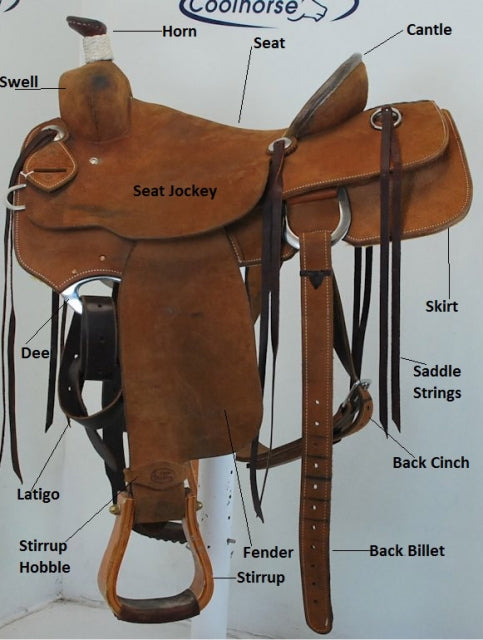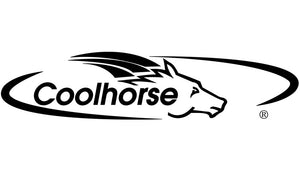Parts Of A Western Saddle

Shelbi |
There are many parts to a western saddle.Do you know all the parts of a western saddle? This is going to cover the parts of a western saddle very briefly. Lets start with the tree of the saddle, think of it as the frame. The tree will play into affect on the shape of the cantle and the seat of the saddle.The gullet width and angle of the bars on each saddle will be different. If a saddle has a wide gullet it is going to sit lower on a horse. A wider gullet will help if the horse does not have much wither or if they are thick across their top line. Now, if a horse with a higher wither a narrow gullet might fit better since they sit higher. The bars of the saddle run from the front of the saddle to the back and this is where the weight is distributed over the horses back. With that being said a horse with a flat wide back will need the bars on the saddle to have more flare to them. A horse the is narrow over the top line will need to bars to be steeper.
The rigging is one of the most important parts of the saddle because it connects the straps (latigo, cinch & billet) that hold the saddle in place. A saddle can have either a single or double rigging. A single means the saddle just has it on the front and a double is when a saddle has it on the front and the back. There are three styles of riggins they are ring, in-skirt and flat plate. The riggin ring are attached to the tree of the saddle. The will be very strong however it will be more bulky under the riders leg. In-skirt rigging ring or plate will attached to the saddle on the skirts. They will be lighter weight and there will be less bulk under the riders leg. Last of all is the flat plate which attached directly to the saddle tree.
The saddle fork or swell is the front of the saddle tree. This is what the bars connect to and the saddle horn. The are anyway from 8-14 inches in width. Saddle forks having change over time to for many reason one of them being style and the other depends on what discipline the horse is doing. The fork also secure the rider in the saddle.
The saddle horn is how people recognize western saddles. It attaches to the tree of the saddle, often times it is used when roping cattle or for riders to hold onto. Different types of saddles while have different horn shapes that best fit that saddle.
The saddle seat is a very important part of the saddle because if it is not comfortable well then riding is not enjoyable. Seat range in opinions and it is going to depend on what the rider is doing with their horse. Most riders prefer to ride in a saddle with a flat or low seat allowing their legs to be underneath them, helping with balance. If the saddle has a higher slope it tends to force the rider back towards the cantle thus, making the riders leg more forward and become unbalanced.
Moving back to the cantle it is the upright portion behind the seat. It also holds the bars together at the back of the tree. It secures the rider from slide off a horse. Cantles will vary in height, ranging anyway from around 2-6 inches. Again, it is all going to depend on what the rider is doing to determine how high the cantle needs to be.
The jockey or housing cover the tree and bars of the saddle. The are positioned on top of the skirts. A saddle will have the front, back and seat jockey. Also, this helps protect the riders leg from rubbing on the rigging and stirrup leathers. Conchos, screws or strings attach the jockey to the saddle.
The skirt are leather pieces that attached to the bars. The main purpose of the skirt is to protect the horse from the bars, it helps to distribute the riders weight over a larger area and helps the rider from getting in touch with the horse. The skirt is laced together in the back of the saddle. The main shapes of a saddle skirt are round or square. The underside of the skirt is made of sheepskin or synthetic fleece. This is one way your saddle blanket stays in place as it creates friction between the pad and the fleece.
The saddle fender is a long piece of leather that is under the riders leg. This design is so the riders leg does not come in direct contact with the horse. Fenders will be smaller at the top under the jockey so it less bulky under the riders upper leg.
The stirrups are where the rider places their foot. There are variety's of stirrups just like everything else on a saddle. Deeper treads make for more comfort for long rides. Thinner treads make for more control for competition or training. The stirrup leathers are the piece of leather that attach to the stirrups and the saddle tree. You can adjust the length to the rider. It is a good idea to turn the stirrup leathers forward this allows the rider to get their foot in the stirrup easier. The stirrup hobble is a small piece of adjustable leather that is placed on the bottom of the fender. It helps hold stirrup leathers and the fender together. It will also help for the stirrup to be turned out
The front cinch is what secures the saddle to the rigging. They are made out of a variety of materials and range in size. It is very important to make sure your cinch is in good condition and that it fits the horse properly. Having a clean cinch is good practice to prevent saddle sores or fungus. The back cinch will help keep the back of the saddle in place. In order for a back cinch to work correctly it has to be tight enough to prevent tipping. Another reason to keep the back cinch tight is because a horse can get foot stuck if it hangs too low. A very important piece of tack if using a back cinch is the cinch hobble strap. This connects the back cinch to the front cinch to prevent the back cinch from shift backwards towards the horses flank.
